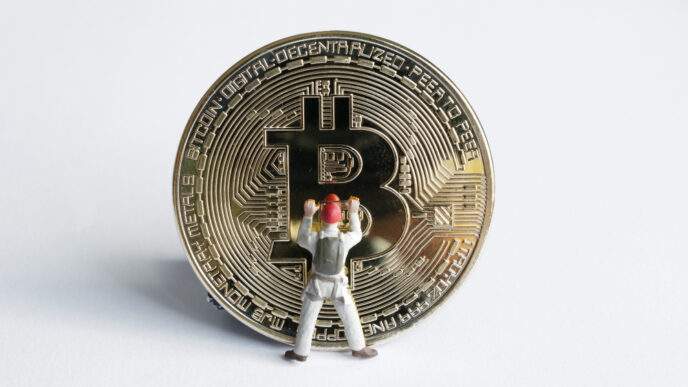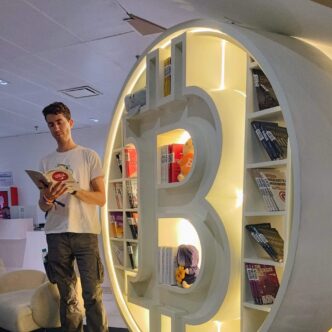In a recent conversation on the Stephan Livera Podcast, Kevin Cai, Engineer at Lightning Labs, shared his perspectives on the current discussion around Spam, CSAM, Policy, Consensus, Mining Incentives and the BIP444/USAF proposal.
Table of Contents
Bitcoin Spam: A Libre Relay View with Proof of Cash | SLP703
Introduction
Unlike popular understanding, Bitcoin’s blockchain is more than just a network to transfer value without third-parties. It’s a decentralized, censorship-resistant digital ledger that anyone can use for monetary and non-monetary activties. As Bitcoin’s popularity grows, so does a controversial problem: “spam” transactions—those that some see as unnecessary data clogging the network, while others defend as lawful uses of a permissionless system. This heated debate raises fundamental questions about Bitcoin’s identity, if filtering is needed, and who gets to decide what is valid on a truly open blockchain. Balancing network efficiency with Bitcoin’s core ethos of freedom is one of the community’s biggest challenges. Technical education and unbias judgment are rare to find and the thesises and arguments laid out by Kevin Cai are a valuable resource for everyone interested in a rational approach to the complex subject.
In summary, Kevin has three main arguments about the nature of blockchain spam and the right way of dealing with it.
- Spam is subjective and tied to policy, not consensus. What one user calls spam, another may see as legitimate use. Bitcoin’s consensus rules are strict and uniform, but policies—how nodes choose to relay or filter transactions—are subjective and vary by operator. This means spam can’t be universally defined or banned without risking censorship.
- Bitcoin’s censorship resistance must be preserved at all costs. Blocking transactions labeled as spam risks undermining Bitcoin’s core promise of permissionless, uncensorable money. Kevin fears this path leads to scenarios where nodes selectively validate transactions, weakening network trust and decentralization.
- Economic realities and miner incentives should guide spam policies. Instead of imposing consensus-level bans, the network should evolve organically, letting miners balance transaction inclusion with orphan risk and fee revenue. Tools like Libre Relay help align incentives to keep Bitcoin open and functional without heavy-handed filtering
55 Arguments Why Fighting Spam Could Kill Bitcoin
Below is a list of some of the core statments and arguments Kevin made during the conversation.
1. Defining spam on Bitcoin is subjective; the line between consensus (strict rules) and policy (optional node preferences) is crucial.
Quote: “Ultimately when it comes down to categorizing what is spam and what is not spam, it becomes a subjective judgment. I think that it’s important to make the distinction between what is consensus and what is policy.”
- Additional Explanation: Kevin stresses that “spam” is not a purely technical classification, but depends on individual perspectives. The difference between consensus (network-wide rules) and policy (node-specific behavior) determines the debate’s boundaries.
2. Libre Relay nodes do not exclusively connect only to other Libre Relay nodes; they also connect with Core and Knots nodes.
Quote: “One of the biggest misconceptions about Libre Relay is that a Libre Relay node only connects to other Libre Relay nodes. This is actually not the case.”
- Additional Explanation: Kevin clarifies Libre Relay’s interoperability, refuting the idea that it operates as a closed system, emphasizing its alignment with Bitcoin’s open network design.
3. Determining spam is not binary but a points-based system based on threshold probabilities.
Quote: “Whether or not something is spam is not a binary decision that I make right off the bat, but more of like a points-based system. You exceed some sort of threshold, then now the probability that you’re spam is much higher than the probability that you’re not.”
- Additional Explanation: Kevin argues for a nuanced approach, recognizing varying degrees of “spamminess” rather than treating all questionable transactions equally.
4. There are different camps in the Bitcoin spam debate: Knots (favor filtering), Bitcoin Core (mixed views), Libre Relay (censorship resistance), and Ordinals (different ecosystem).
Quote: “There are let’s say different camps right … there’s the knots camp right they’re kind of pro filter … there’s libra relay right … and then let’s say there’s the ordinals camp … and these are kind of different camps and you know they don’t necessarily all agree on everything.”
- Additional Explanation: This division demonstrates that the debate is multi-faceted, with groups prioritizing technical, ideological, or pragmatic approaches.
5. Kevin aligns politically with Libre Relay for promoting censorship resistance and aligning consensus with policy.
Quote: “If I had to get put onto like a political compass … I would probably align myself most closely with what Libre Relay’s ethos is … it tries to align consensus with policy in a way where miners have the incentives aligned as well as users who are just trying to make consensus valid transactions.”
- Additional Explanation: Kevin’s alignment illustrates the core values driving his stance—maximizing Bitcoin’s censorship resistance by ensuring local policies reflect consensus rules.
6. Bitcoin’s greatest feature is unstoppable currency resistant to government sanctions or protocol changes.
Quote: “We also managed to create an unstoppable form of currency that governments … would not be able to stop either through sanctions, either through just trying to control the protocol and change it.”
- Additional Explanation: This highlights the robustness of Bitcoin as a global, uncensorable monetary system, even under coordinated efforts to control it.
7. Libre Relay attempts to align miner incentives with users trying to make consensus-valid transactions.
Quote: “Libre Relay just makes sense in that it tries to align consensus with policy in a way where miners have the incentives aligned as well as users who are just trying to make consensus valid transactions.”
- Additional Explanation: The aligned incentives reduce opportunities for censorship by ensuring that economic and network incentives support permissionless participation.
8. Onchain services like Sats Dice may create transactions some view as wasteful but others see as onboarding users.
Quote: “I want people to try out Bitcoin and… Maybe even, you know, make a few sats in the process. It’s an exciting… little gambling application that I’ve put together. To somebody else, their subjective view of that may be these transactions don’t need to happen at all.”
- Additional Explanation: Kevin sees experimentation and use-cases as valuable, while acknowledging opponents who see these as unnecessary chain pollution.
9. The distinction between consensus and policy is vital—consensus must be agreed network-wide, but policy can vary by node.
Quote: “Policy is a guideline. It’s a nudge that we use to try and push users to behave a certain way. Consensus is all or nothing … you either follow consensus, you’re … contingent on doing things in a consensus valid way or your consensus invalid and the network will reject your transaction.”
- Additional Explanation: This distinction serves as the backbone for debates about what Bitcoin nodes should or should not relay, filtering, and individual freedoms.
10. Subjective judgments on transactions often ignore the core principles of Bitcoin’s permissionless and censorship-resistant nature.
Quote: “It’s really easy for people who are making these subjective sort of judgments on transactions to say, well, you’re making transactions that I view as unnecessary, as spam, so you’re a bad actor … But … if you replace the word spam with an OFAC non-compliant transaction, you could very well make the same sort of compliance-based argument.”youtube
- Additional Explanation: Kevin draws parallels to compliance politics, warning that labeling transactions as “spam” creates a slippery slope for censorship.
11. Comparing blocking spam to censoring OFAC non-compliant transactions shows the risk of undermining network principles.
Quote: “Why am I going out of my way to store your OFAC non-compliant sanctions violating transaction? … The end result is why am I storing other people’s transactions at all?”
- Additional Explanation: Overzealous filtering risks neutralizing Bitcoin’s intended censorship resistance and undermining its utility for all participants.
12. Bitcoin’s decentralized redundancy makes the network anti-fragile—more adoption improves resistance to attack.
Quote: “By joining together all of our resources … we can create a level of redundancy and reliability that no other system on Earth begins to approximate.”
- Additional Explanation: Decentralization gives Bitcoin unmatched resilience; removing nodes or censoring data weakens this robustness.
13. Node policy means users can choose which peers to connect with, expressing personal node preferences.
Quote: “Policy means things that it’s like you set this on your own individual node and we can all set different defaults … you can set your setting more permissive and more liberal than I have.”
- Additional Explanation: This enables a flexible, diverse network where node operators reflect their values without forcing change on others.
14. Nodes should be free to connect preferentially based on their own criteria, akin to freedom of association.
Quote: “A lot of people in the Bitcoin space are libertarians … freedom of association. That your individual liberty should entitle you … who you will associate with … when I apply that same lens of ideology to Bitcoin nodes, I don’t see the difference.”
- Additional Explanation: Kevin compares node peering choices to social liberties, reinforcing the right to select or exclude peers based on individual beliefs or interests.
15. Scripts taking long to validate were the original reason for standardness policy introduction, but modern inscriptions are cheap and fast to validate.
Quote: “Where I do draw the line are scripts that take a very long time to validate … OP returns are very cheap to validate. Even inscriptions with their envelope are cheap to validate.”
- Additional Explanation: Policy originated from the need to protect the network from resource abuse; Kevin argues that current inscription practice does not pose this harm.
16. Transactions with inscriptions or OP_RETURN are faster to validate than monetary transactions.
Quote: “Blocks that are consistently filled with inscriptions are actually faster to validate than blocks that are filled with monetary transactions because in the monetary case you’re actually executing scripts.”
- Additional Explanation: This challenges claims that inscriptions are inherently harmful, reframing them as less demanding than regular payment transactions.
17. Banning certain transaction types via consensus is unjustified unless they cause real harm.
Quote: “The types of transactions that we’re debating banning through consensus through a soft fork are not strictly harmful in the same way … as those that introduced the need for standard checks in the first place.”
- Additional Explanation: Kevin warns against preemptive consensus changes and insists on clear evidence of harm before altering Bitcoin’s rules.
18. Blockchain growth is linear and predictable; storage costs are dropping exponentially.
Quote: “Blockchain is growing is still linear. It’s very predictable and storage drops at a power law price. Every year, uh, storage is getting cheaper and cheaper as manufacturers improve their ability to manufacture high density storage.”
- Additional Explanation: He rebuts fears of untenable storage costs, pointing to technological advancement and the steady nature of chain growth.
19. Node hardware is more accessible and affordable than commonly perceived due to market improvements.
Quote: “We’re even seeing a cottage core industry of node in a box solutions … they’re packaging like nice crucial SSDs in there.”
- Additional Explanation: Dedicated node devices lower technical barriers, supporting decentralization and robust network health.
20. Claims about storage bloat causing urgent consensus changes are overblown.
Quote: “I think it … ‘s a very overblown set of risks that are being used to justify this very um you know subjective approach to determining what is a good transaction, what is a bad transaction, what is good for the network, what is harmful for the network.”
- Additional Explanation: Kevin challenges storage panic narratives, showing that technological improvements and predictable blockchain growth mitigate these fears.
21. Paying users create network security value by funding miners through fees, unlike non-transacting holders.
Quote: “You are a paying customer on the Bitcoin network. You are funding the security that I benefit from … I’m a free rider. I’m not contributing to the security costs … for those reasons, I think that it’s just incredibly silly to try and go after paying customers of Bitcoin.”
- Additional Explanation: Transactions pay for network security; targeting fee-paying users undermines sustainability.
22. Trying to ban transactions from paying customers is counterproductive for network economics.
Quote: “It would be as if you were running a corner store and because you don’t like the way somebody looks, you chase them out of your store, even though your store could use all the revenue that it could get.”
- Additional Explanation: Exclusion based on taste harms economic health and contradicts the core business model of mining in Bitcoin.
23. Concerns about very small UTXOs are nuanced; dust limits should prevent outputs costing more to spend than they’re worth.
Quote: “I think that it’s definitely good to set a semblance of a dust limit that makes sense and that you’re not creating an output that costs more than to, you know, actually spend it uh and doesn’t hold as much value to justify its existence.”
- Additional Explanation: Dust limits function as a safeguard against trivial outputs, balancing network efficiency and usability.
24. The UTXO set size misconceptions cause unnecessary panic; large UTXO sets can run on modest hardware.
Quote: “You can have a 100 GB UTXO set and still run a Raspberry Pi with Bitcoin core … A lot of the reasons why people end up having such a slow node do comes down to misconfigurations for their hardware and not necessarily because of particular transaction history.”
- Additional Explanation: Kevin demystifies hardware concerns, stressing proper configuration over UTXO count.
25. Consensus changes should only happen reactively to actual abuses, not preemptively.
Quote: “I would look at this from a more reactive perspective rather than a proactive perspective. I would like to see some evidence that people are actively abusing this and then move to enshrining this in consensus and change it. Until then, I don’t really think there’s much point in changing consensus in order to try and prevent a certain kind of bad behavior.”
- Additional Explanation: System changes should be grounded in real, evidenced threats rather than theoretical risks.
26. Bitcoin Core codebase files related to consensus rarely change due to the risk involved.
Quote: “There are files that haven’t been touched in years and years and years. Almost all of those files are consensus … consensus changes are so incredibly fraught with peril that, you know, we don’t even lint them … Unless there’s an urgent reason to change consensus.”
- Additional Explanation: Developers approach consensus code with extreme caution, prioritizing stability over convenience.
27. Filters like dust limits work by socially norming behavior, but that does not mean they are perfect.
Quote: “The dust filter is an example of a filter that works … Not much has changed there, right? … There’s not a lot of people who are trying to get around the dust limit.”
- Additional Explanation: Filters can shape transaction behavior, but do not completely eliminate “spam”—they create norms, not absolutes.
28. Fee market dynamics are influenced by latency in adoption, wallet defaults, and user behavior patterns.
Quote: “What ends up happening here is a lot of people conflate an equilibrium with the sort of actual barriers that exist … There’s a latency, a lag in adoption to a new sort of de facto standard … users perceive one per vite to be the minimum safe fee.”
- Additional Explanation: Adoption of new fee policies is slow due to default settings and ingrained mental models.
29. Subsat fee transactions appeared despite nodes rejecting them initially, driven by miner acceptance and user experimentation.
Quote: “We saw a small group of people starting to put subsat fee rate transactions on chain … miners were willing to mine … as they continued pulling on that thread they realized … Sparrow wallet had a PR that went up that would check to … see what your min relay TXV was for your core node.”
- Additional Explanation: Change can start at the margins and propagate via new features and miner economic incentives.
30. Clusters of fee rates reflect real human incentives and technical constraints, not uniform random distributions.
Quote: “Very few distributions are actually uniform. I would expect to see more of a biodal distribution where you have two spikes in the graph and what do you know if you look at that graph that’s exactly what you see.”
- Additional Explanation: Real-world fee data reflects the collective choices and constraints of users and developers.
31. Fee rate and dust limit behavioral changes take months or years to propagate widely.
Quote: “If core v31 lowers the dust limit, you can now make one outputs. I don’t believe that overnight you would start seeing one set outputs everywhere. I think that there would be a latency. I think that it could be months if not years …”
- Additional Explanation: Behavioral change in protocol usage is slow, even when technically permitted, due to entrenched habits and slow information dissemination.
32. Risk-averse users delay adopting new fee policies despite practical possibilities.
Quote: “Because a lot of Bitcoiners are very risk averse, even if they know something is possible, they may not be willing to hazard trying that out until more and more people have done it.”
- Additional Explanation: Social proof and perceived risk dominate fee policy changes more than technical feasibility.
33. Miner orphan rates increase with more strict filtering, potentially reducing miner revenue.
Quote: “In regards to Mara originally taking 0.1 for vite transactions and then you know doing some math, recalculating their risk and then deciding that 0.5 was more appropriate … propagation delays. Roughly for propagation delays, that translates to approximately a 1% chance that the network would out compete your particular pool.”
- Additional Explanation: Over-filtering decreases miner profitability by increasing the chances of orphaned blocks due to slow transaction relay.
34. Miners peer on high-bandwidth, low-latency networks like fiber to reduce orphan risk.
Quote: “Miners very often will peer over high you know bandwidth low latency connections to miners directly using things like fiber which also you know makes use of UDP instead of TCP …”
- Additional Explanation: Dedicated relay channels improve block propagation speed and reduce economic risk.
35. Spy mining—mining on an uncle block before validating it—is a competitive tactic miners use.
Quote: “Spy mining is when you don’t actually wait to hear a block from a competing pool before mining on top of it … you’re connected over stratum without being able to validate if that block is actually valid … gives me the advantage that I will be one of the first people to begin mining the block …”
- Additional Explanation: Spy mining increases block production competitiveness at the cost of possible error propagation.
36. Smaller miners face less orphan risk from filtering than large centralized miners.
Quote: “If you’re running a smaller mining operation like what I’m doing in my basement with a few hundred terraashes per second of hash rate … probably not as big of a deal to you.”
- Additional Explanation: Orphan risk, and its economic impact, depends greatly on miner scale and relay reliance.
37. Miners balance inclusion of low-fee spam transactions against orphan risk to optimize revenue.
Quote: “There’s an economic trade-off between accepting spam and increasing orphan risk. Mara is operating out of an abundance of caution here.”
- Additional Explanation: Mining policy dynamically responds to fee market conditions; thresholds adjust to optimize profitability.
38. Most miners do not use Libre Relay for block template construction but benefit from hearing transactions through it.
Quote: “Not one minor out there to my knowledge uses Libre Relay as their block template constructor. They simply hear with one Libre relay node and that’s enough to get those transactions into their own mempools.”
- Additional Explanation: Libre Relay serves as a tool for transaction relay rather than direct mining coordination.
39. Filtering nodes increase propagation delay, leading to a roughly 1% orphan risk from delayed transaction relay.
Quote: “Filtering node you’re looking at about 6 seconds roughly for propagation delays. Um and that translates to approximately a 1% chance that the network would out compete your particular pool …”
- Additional Explanation: Increased propagation delay slightly raises orphan risk, imposing economic costs on miners.
40. There’s an economic trade-off between accepting spam and increasing orphan risk.
Quote: “If Bitcoin’s price continues goes going up, that will drop from 0.5 sats per vite, maybe down to 0.4, right? … gaining so little revenue from including these transactions that risking any bit of orphaning is just not worth it.”
- Additional Explanation: Miner behavior adapts dynamically to fee levels and price trends.
41. Miner policies regarding minimum relay fees vary based on economics and operational scale.
Quote: “Miner policies regarding minimum relay fees vary … Not all miners operate the same way … spiderpool is peered with Mara.”
- Additional Explanation: Diverse economic incentives shape relay policy heterogeneity across the mining ecosystem.
42. Networks are highly redundant, so bypassing traditional relay via preferential peering does not isolate nodes from transactions.
Quote: “Highly redundant connections … you don’t have to actually bypass the public relay network you just have to convince enough people that you can create a path from point A to point B not dissimilar to lightning …”
- Additional Explanation: Transaction relay resembles routing redundancy in Lightning; filtering does not cut off transaction flow entirely.
43. Libre Relay’s small patch set maintains compatibility with other node implementations.
Quote: “The beauty of Libre Relay is that it is a small set of patches … it changes very little … so you’re identifying yourself as a Libre relay node and then you’re looking around on the DNS seed for Libre relay nodes …”
- Additional Explanation: Minimal changes ensure interoperability and network composability.
44. Node operators can write scripts to preferentially connect to similar nodes, mirroring Libre Relay’s behavior.
Quote: “You can write a 10line bash script to do that. If you don’t know how to write scripts, you can go ask Google Gemini or ChatGBT to do it for you.”
- Additional Explanation: Preference-based peering is accessible and customizable, enabling organic policy diversity.
45. The libertarian principle of freedom of association supports nodes choosing their peers.
Quote: “The freedom of association … should entitle you the ability to freely choose who you will associate with … when I apply that same lens of ideology to Bitcoin nodes, I don’t see the difference.”
- Additional Explanation: This supports diversity and pluralism in node operations and network composition.
46. Nodes not carrying all consensus-valid transactions are defective from a censorship resistance perspective.
Quote: “I don’t have any interest in connecting to nodes that I know are not going to carry a subset of my transactions throughout the network. They are in my opinion defective. They don’t achieve what a node is supposed to do, which is remain neutral and carry any consensus valid transaction throughout the network.”
- Additional Explanation: Network neutrality underpins Bitcoin’s resistance to censorship and centralization.
47. Over time, policies and filters evolve as network participants react to economic incentives and threats.
Quote: “Policies and filters evolve … as network participants react to economic incentives and threats.”
- Additional Explanation: Economic and technical changes drive policy adaptation, maintaining system health and flexibility.
48. Arbitrary data embedding in transactions is inherent to communication systems built on Bitcoin.
Quote: “Arbitrary data embedding is inherent to communication systems.”
- Additional Explanation: Bitcoin’s design accommodates open-ended data use cases as a fundamental property.
49. Temporary protocol fixes (like RDTS) pose risks and waste developer effort.
Quote: “Temporary fixes may lead to wasted time and effort … the RDTS poses risks to user transactions and programmability.”
- Additional Explanation: Kevin cautions against knee-jerk protocol tweaks, which often have unintended consequences.
50. Programmability is crucial for Bitcoin’s long-term utility and future application development.
Quote: “Programmability is crucial for Bitcoin’s future applications.”
- Additional Explanation: Flexible programmability enables new features and broadens Bitcoin’s functional scope.
51. Blocking inscriptions on-chain is unlikely to succeed given the network’s permissionless nature.
Quote: “Blocking inscriptions is unlikely to succeed … Bitcoin’s permissionless nature allows for innovation without approval.”
- Additional Explanation: The open design will continually frustrate attempts at categorical restrictions.
52. Market demand for low-fee transactions has stayed consistent despite changing miner policies.
Quote: “There’s staying power in subset transactions that there’s enough economic demand for these cheap transactions …”
- Additional Explanation: Economic incentives drive repeated adoption, despite shifting technical barriers.
53. Decentralization of mining reduces the ability of small miners to punish spam collectively.
Quote: “Can all the small miners gather to punish spam on Bitcoin? Decentralizing mining.”
- Additional Explanation: Distributed mining weakens the ability to enforce collective standards on transaction content.
54. Cultural and ideological differences strongly influence how participants perceive spam and filtering.
Quote: “Cultural perspectives on Bitcoin and spam … Subjective judgments about transactions can lead to disagreements within the community.”
- Additional Explanation: The debate touches values, identity, and philosophy as much as technology.
55. The future of transaction policies will evolve based on user behavior, economic incentives, and ecosystem growth.
Quote: “The future of Bitcoin transaction policies will likely evolve based on economic incentives and user behavior.”
- Additional Explanation: Network policy will develop organically as new actors enter, incentives shift, and technical capabilities grow.
Conclusion
The Bitcoin spam debate highlights a fundamental tension at the heart of the network’s future: balancing the principles of censorship-resistant, permissionless money with the practical challenges of network congestion and transaction filtering. As innovation like data inscriptions and Ordinals alter Bitcoin’s use cases, the community faces hard choices about what defines valid use and who sets the rules. The debate has technical and ideological level, reflecting divergent visions for Bitcoin’s role as either a pure monetary network or a decentralized database. Navigating these tensions carefully will determine whether Bitcoin can maintain its core ethos whithout risking consensus changese.
FAQ
Q: What is Bitcoin spam?
A: Bitcoin spam refers to transactions perceived as unnecessary or wasteful by some network participants. However, “spam” is subjective and depends on individual node policies rather than strict consensus rules.
Q: What’s the difference between consensus and policy in Bitcoin?
A: Consensus rules are the strict, network-wide protocols all nodes must follow for the blockchain to remain valid. Policy refers to optional local settings nodes use to decide which transactions to relay or filter, allowing personal preferences without breaking consensus.
Q: What is Libre Relay?
A: Libre Relay is a Bitcoin node implementation that prioritizes censorship resistance by aligning policy more closely with consensus, aiming to relay all consensus-valid transactions to preserve permissionless access.
Q: Why is censorship resistance important in Bitcoin?
A: Censorship resistance ensures no single party can control which transactions are included in the blockchain, preserving the open, permissionless nature of Bitcoin as decentralized money.
Q: What are dust limits?
A: Dust limits are thresholds set to avoid tiny outputs that cost more to spend in fees than their value. They help protect the network from bloating with uneconomical, trivial transactions.
Q: What is an orphan block?
A: An orphan block occurs when two miners find competing blocks nearly simultaneously, but only one is accepted into the chain. Orphans can cause miners to lose block rewards and create economic risk.
Q: What are inscriptions and Ordinals?
A: Inscriptions and Ordinals allow embedding arbitrary data (like images or text) into Bitcoin transactions. They’re controversial as they increase non-payment data on the chain, fueling the spam debate.
Q: What is miner incentive alignment?
A: Miner incentives include transaction fees and minimizing orphan risk. Policies like fee thresholds evolve based on these incentives to balance profitability with network health.
















